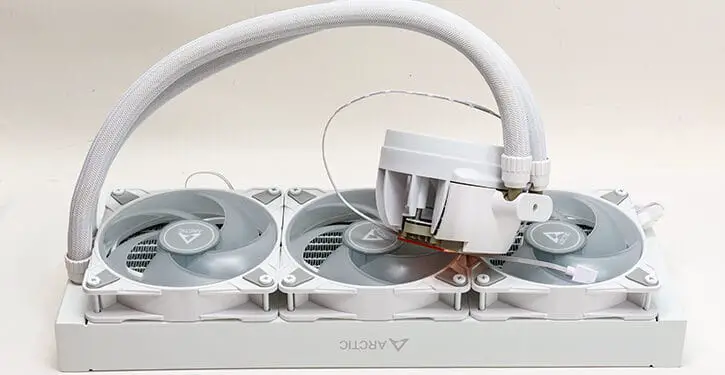
Moving on the to the cold plate… Back in the ALF 1 days Artic had a cold plate big enough to basically offer HEDT coverage and laughed at Intel and AMD consumer CPU’s IHS sizes. Intel and AMD have both since gone to bigger IHS… and yet AIO cold plate sizes have not kept up. As we all know any part of the IHS that is not covered by the cold plate is not going to get actively cooled. This in turn is the reason why AMD ‘offset mounting’ was required on AIOs… as the cold plate was not big enough to handle the hotspot’s change in location. In the ALF 2 days this additional mounting option was an acceptable compromise. However, with the ALF 3 Arctic has not increased the cold plate dimensions of ~32×28.5mm. Instead all they did was bake the AMD offset directly into the block and removed the original mounting option.
Sigh.

This means that one cannot turn the block 180 degrees to eliminate the M.2 z-height restriction issue. This is why you can’t even twist the block 90 degrees to give the M.2 port some cooling and the VRM some cooling. Instead you can only install the ALF 3 one way. The Arctic Way. Everyone likes to joke about the rigidly of zee Germans and zee Swiss, but this is taking things too far (and well into “toilet trained with a shotgun” OCD territory). System builders should be given the luxury of choosing to use or not use an offset. To choose what direction to install a block. The freedom to make a custom system their way. This rigidity and inflexibility hopefully will be changed in future revisions… by taking advantage of the better pump and using a bigger cold plate.

On its own this issue would be bad enough. Still tolerable, but pushing things. Sadly it is not. The downside to a big boi waterblock is… its big.

To borrow a certain quote and mangle it “You just won’t believe how vastly, hugely, mind-bogglingly big it is. I mean, you may think it’s a long way down the road to the chemist’s, but that’s just peanuts to this block.” Okay. That is a bit hyperbolic, but not by much… as it is so big it overflows the CPU area and right into the PCIe slot zone. Worse still, the ALF 3 does not respect PCI-SIG ‘no-go’ zones with regards to z-height restrictions. To be precise it intrudes upon the topmost PCIe slot’s area with extreme prejudice… bordering on ‘aggressive romantic intent’. Yes. That topmost PCIe slot was pretty much useless and rarely used, and that was probably the reasoning behind ignoring the PCIe standards way back when Artic started designing the ALF 3. These days that zone is now extremely important… as the top most PCIe slot has been modded into a PCIe 5.0 x4 M.2 2280/2210 slot. AKA the typical system’s “C Drive” M.2 port. AAKA the port where the hottest running M.2 drive resides and needs as much cooling as it can get. Sadly, it is not going to get as such as it should when it lives in ALF 3’s house.

To be precise, with the AMD ‘offset’ baked directly/natively into the ALF 3, the inlet/outlet ports invade the M.2 zone by a whopping ~16mm. To be fair, even if it was just disrespecting PCI-SIG by a mere 1mm, the end result would be the same: decreased 3rd party M.2 cooling solution compatibility. Significantly reducing it as this overhanging of said M.2 port will restrict M.2 heatsinks to ~28mm in height (and 25 is a more comfortable hard “safe” limit).

To put this restriction in perspective, a Sabrent Rocket/Colossus sits about ~25mm above the M.2 PCB; an Acidalie/Elecgear is ~30mm; a Thermalright HR10 is about 42’ish; the Thermalright HR-09 Pro is about 75mm. These four represent some of the most popular aftermarket M.2 heatsinks in North America right now. Of the four only the Sabrent will work with the ALF 3. Which translates to a good 8 to 10 additional degrees on a PCIe 5 x4 SSD when pushed hard compared to the HR10, and add another 5 or so degrees when compared to the HR-09 Pro… and add another 5 or more when dealing with actively cooled variants of said chonky bois.
Make no mistake it is not just 3rd party heatsinks that will be affected by this arbitrary z-height limitation. For example, the MSI Spatium M570 Pro’s stock heatsink will not fit underneath the ALF 3’s block. In the coming years more and more enthusiast grade SSD’s will come with heatsinks that make the M70 Pro look small… as PCIe 6 M.2s are expected to have a TDP in the 25-30 watt range and require massive passive cooling abilities.

Thus, for some this will not be a deal-breaker for right now or even 2025. After all, most M.2 drives come with lower than 28mm height heatsinks, and most motherboard’s “stock” M.2 heatsinks are equally “low profile”. The operative word is most… as “the times they are a changing”.
Motherboards are starting to come standard with excellent, robustly built M.2 heatsinks that are also rather tall. ASUS’ RoG CrossHair Hero X860E is an excellent example of this necessary trend. A trend which will trickle down from the uber-high end to the more moderately priced motherboards in the coming years. We feel very comfortable in stating that if forced to choose between the two, few will opt to keep the ALF 3 over their new ~1K CAD motherboard. We seriously doubt many will even pick the ALF3 over a $300 motherboard. Thus turning this from a potential deal breaker… into the ALF 3 quickly migrating on to experienced builders ‘do not buy’ list in the coming years. Hopefully, before that doomsday scenario occurs a future ALF 3 revision will have… less “romantic intent” towards PCI-SIG standards and allow builders to use the best of the best M.2 heatsinks and/or whatever motherboard their customer wants.

To be fair, Artic will send you, free of charge, a M.2 heatsink if and only if your motherboard is on their short list of officially affected motherboards. It however is nowhere near as impressive as the ALF 3 design.

As you can see it is a low-profile, solid aluminum, 2-piece “snap fit” style cooling solution… that only weighs 1.5oz. Which is well below our comfort level for 10watt’er NVMe PCIe 5.0 SSDs. So while it would ‘okay’ for PCIe 4. It is cold comfort if you forced to use it because Arctic didn’t want to make their ‘block tall enough to nullify this issue.

Ooof… and oooooof again. Thankfully, it is not a complete deal breaker as good 3rd party M.2 coolers do exist and not every, not even most motherboards are going to be impacted by this issue. By the same token Arctic need to invest a couple bucks in a heatpipe based solution as this freebie is basically worth every penny you pay for it. Put bluntly if Sabrent can do it, Arctic can do it. They just need to put their back into it.












